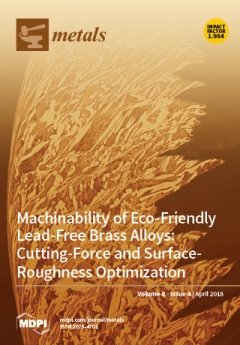Fabrication of Fe
3Al–TiB
2–Al
2O
3 composites with a broad range of phase compositions was studied by combustion synthesis involving aluminothermic reduction of oxide precursors. Two reaction systems composed of elemental Fe, amorphous boron, and a thermite mixture of
[...] Read more.
Fabrication of Fe
3Al–TiB
2–Al
2O
3 composites with a broad range of phase compositions was studied by combustion synthesis involving aluminothermic reduction of oxide precursors. Two reaction systems composed of elemental Fe, amorphous boron, and a thermite mixture of Fe
2O
3/TiO
2/Al were conducted in the mode of self-propagating high-temperature synthesis (SHS). One was to produce the composites of 1.25Fe
3Al +
xTiB
2 + Al
2O
3 with
x = 0.3–1.0. The other was to fabricate the products of
yFe
3Al + 0.6TiB
2 + Al
2O
3 with
y = 1.0–1.6. Reduction of Fe
2O
3 by Al acted as an initiation step to activate the SHS process. Complete phase conversion from the reactants to Fe
3Al–TiB
2–Al
2O
3 composites was achieved. The variation of combustion front velocity with sample stoichiometry was consistent with that of the reaction exothermicity. Based on combustion wave kinetics, the activation energy of
Ea = 86.8 kJ/mol was determined for formation of the Fe
3Al–TiB
2–Al
2O
3 composite through the thermite-based SHS reaction. In addition, with an increase in TiB
2, the fracture toughness of the 1.25Fe
3Al +
xTiB
2 + Al
2O
3 composite was found to increase from 5.32 to 7.92 MPa·m
1/2.
Full article





